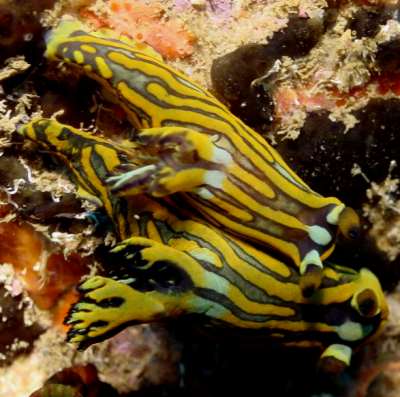
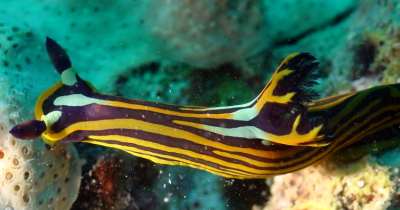
Tambja affinis
(Eliot, 1904)
Order: NUDIBRANCHIA
Suborder: DORIDINA
Superfamily: ANADORIDOIDEA
Family: Polyceridae
Subfamily: Nembrothinae
DISTRIBUTION
Known from the western Indian Ocean [Sth Africa, Tanzania, Mayotte, Sri Lanka] and Thailand
PHOTO
Upper: 'Cowrie', Bentota, Sri Lanka. Indian Ocean. Depth: 23 m. Length: 50 mm. 02 November 2004. rocks covered in fixed invertebrates. Photo: Marina Poddubetskaia. Lower: 'Recif de Peitro', Kongou, Mayotte Island. Indian Ocean. Depth: 11 m. Length: 70 mm. 15 November 2003. rocks. Photo: Marina Poddubetskaia.
See my earlier message [#14564 ] for the original illustrations of this species. The name Nembrotha affinis has been mistakenly used for animals found in many parts of the Indo-West Pacific. See T. affinis colour group page for a comparison of similarly coloured species.
-
Eliot, C.N.E. (1904) On some nudibranchs from East Africa and Zanzibar. Part V. Proceedings of the Zoological Society of London, 1904(2): 83-105, Pls. 3-4.
-
Pola, M., Cervera, J.L. & Gosliner, T. (2005) Four New Species of Tambja Burn, 1962 (Nudibranchia: Polyceridae) from the Indo-Pacific. Journal of Molluscan Studies, 71: 257-267
-
Yonow, N. (1990) Red Sea Opisthobranchia 3: The orders Sacoglossa, Cephalaspidea, and Nudibranchia: Doridacea (Mollusca, Opisthobranchia). Fauna of Saudi Arabia, 11: 286-299.
ARCHIVE NOTE: An earlier edition of this Fact Sheet [28 April 2003] is available on request.
Authorship detailsRudman, W.B., 2005 (August 15) Tambja affinis (Eliot, 1904). [In] Sea Slug Forum. Australian Museum, Sydney. Available from http://www.seaslugforum.net/find/tambaffi
Related messages
Skeleton shrimp on Tambja affinis
March 27, 2009
From: Vie Panyarachun
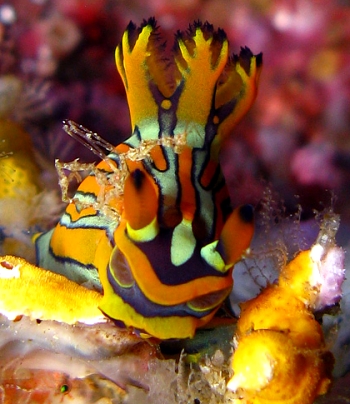
Concerning message #22266:
I was just going through my photos and noticed what might be a skeleton shrimp on this nudi which I think is Tambja affinis? Unfortunately I didn't notice the shrimp (?) when I was taking the photograph and didn't get any closer.
Locality: "West of Eden," Island #7, Similan Islands National Park, 12 msw, Thailand, Andaman Sea, 19 February 2009, Reef. Length: Approx. 1 inch. Photographer: Vie Panyarachun.
Vie
vpanyarachun@hotmail.com
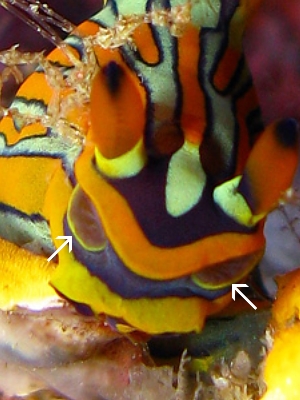
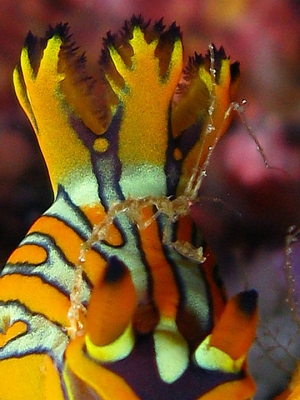
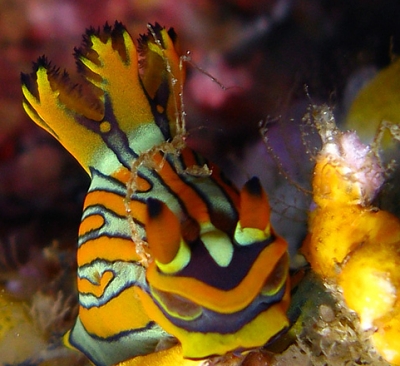
Dear Vie,
Thanks for this message. It shows another nudibranch being harassed by these caprellid shrimps. In the lower photo you can see many more individuals on the yellow coral on the right of the photo. This again suggests that rather than living on the nudibranchs, the caprellids are living in large numbers on the substrate and unlucky passers-by are likely to get a hitch-hiker.
Apart from the shrimps, your photos are interesting because they show an animal that is apparently at the other extreme of the colour variability of the species. The more 'typical' colour form of this species has dark blue rhinophores, while yours has orange rhinophores with dark blue tips. If you look through the other messages on this species you will see a good coverage of animals showing the change from one colour form to the other. The other interesting thing is that your frontal shots show large lappets (or ledges) on each side of the head [see arrows] which I suspect are sensory structures. There are a variety of such organs in the polycerids which are yet to be investigated, so it is good to get some photos of them showing their 'living' state. Often such organs are described from preserved animals and this is not that useful because usually they are considerably distorted or retracted during preservation.
Best wishes,
Bill Rudman
Tambja affinis from Ningaloo Reef, W. Australia
December 7, 2006
From: Kristin Anderson
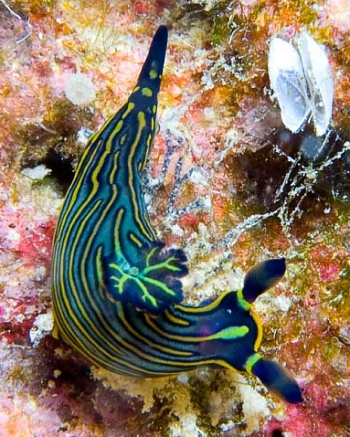
Concerning message #14810:
I came across this small guy while peering into a hole. He was moving swiftly and unfortunately this is the only angle the environment allowed. Is he Tambja affinis?
Locality: Ningaloo Reef, 12m, Western Australia, Indian Ocean, 19 October 2006, limestone & hard coral reef. Length: 1.5cms. Photographer: Kristin Anderson.
Kristin Anderson
kristin@OceansByAnderson.com
Anderson, K.J., 2006 (Dec 7) Tambja affinis from Ningaloo Reef, W. Australia. [Message in] Sea Slug Forum. Australian Museum, Sydney. Available from http://www.seaslugforum.net/find/18871Dear Kristin,
My first thought when seeing this was that it was the new species Tambja victoriae, but on checking the photos from the western Indian Ocean of T. affinis, it certainly looks like as though your species is indeed identical to some I have identified as Tambja affinis. This certainly raises the possibility that T. victoriae is not a good species. When it was described we knew very little about the much older T affinis, but thanks to contributions to the Forum we now have a much better idea of its colour variability. The only real difference I could distinguish before was that in T. affinis the whole of the rhinophore sheath seemed to be coloured while in T. victoriae there was a narrower band right at the edge [see Tambja affinis colour group Fact Sheet] but animals from the Philippines [message #14703] and South Africa [message #14810 ] would appear to be intermediates.
It would be interesting to hear the views of others.
Best wishes,
Bill Rudman
Tambja affinis from South Africa
September 22, 2005
From: Colin Ogden
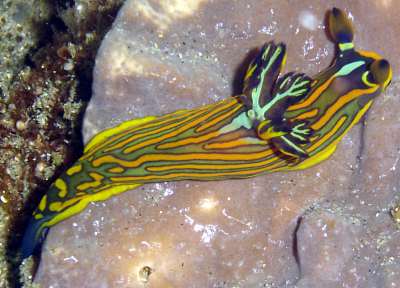
Hi Bill,
On a revent dive I came across this nudi, which from the Debelius book appears to be a Roboastra arika, which I don't find on the forum species list. Am I correct with the ID? It is very different from the R. gracilis which we do find quite often. It was also close to the R. luteolineata, but also has a lot more colour.
Locality: Sodwana Bay, Stringer reef, South Africa, Indian Ocean coast. Depth: 12 metres. Length: 35 mm. 20 September 2005. Coral reef. Photographer: Colin Ogden
Thanks a ton
Colin
scubaco@iafrica.com
Ogden C M, 2005 (Sep 22) Tambja affinis from South Africa. [Message in] Sea Slug Forum. Australian Museum, Sydney. Available from http://www.seaslugforum.net/find/14810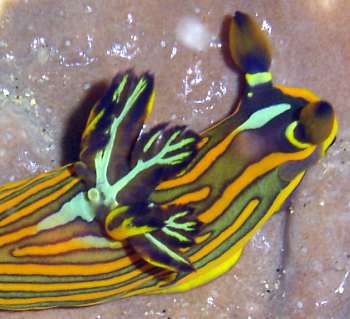
Dear Colin,
Thanks for this beautiful photo of Tambja affinis. It does look quite like the animal which was previously identified as Roboastra arika, but has recently been named Tambja victoriae. Like Marina Poddubetskaia Ossokine's message [#14479] of animals from Ceylon, your animal has rhinophores with blue bases and tips, suggesting that the intensity of the blue pigmentation in this species can vary.
Concerning searching on the Forum. The Species List is a list of current names on the Forum. Where a name has changed I take it off the list but usually leave a 'ghost' Fact Sheet in place to redirect people who are searching for the old name or using an old link. We are in the process of making the search engine on the Forum more 'sophisticated' but if you had searched for arika you would have found the ghost page and earlier messages referring to "Roboastra arika" . Mind you, if you had identified it yourself, we might not have had the pleasure of seeing your photo.
Best wishes,
Bill Rudman
Tambja affinis from Sri Lanka
August 16, 2005
From: Marina Poddubetskaia Ossokine

Dear Bill,
Here is a photo of Tambja affinis from Sri Lanka. This ID was confirmed by Marta Pola, but only from photos (I couldn't collect these specimens).
Locality: 'Cowrie', Bentota, Sri Lanka, Indian Ocean. Depth: 23 m. Length: 50 mm. 02 November 2004. rocks covered in fixed invertebrates. Photographer: Marina Poddubetskaia
It's also an opportunity for me to thank and to congratulate all the team (Marta, Lucas and Terry) for the great job they have done on this genus.
-
Pola, M., Cervera, J.L. & Gosliner, T. (2005) Four New Species of Tambja Burn, 1962 (Nudibranchia: Polyceridae) from the Indo-Pacific. Journal of Molluscan Studies, 71: 257-267
Best wishes,
Marina.
Photos: Marina Poddubetskaia - Nembro website
nembro@nembro.info
Poddubetskaia, M,, 2005 (Aug 16) Tambja affinis from Sri Lanka. [Message in] Sea Slug Forum. Australian Museum, Sydney. Available from http://www.seaslugforum.net/find/14479
Dear Marina,
These are very interesting photos as they show that the yellow bands have black edges just as in T. victoriae. This is usually hidden because the background colour of the body is usually equally dark. This photo also shows the rhinophore clubs are yellow with a purple tip and base, also suggesting that in hevaily pigmented animals they just appear dark blackish purple
Best wishes,
Bill Rudman
Tambja affinis from Mayotte
August 16, 2005
From: Marina Poddubetskaia Ossokine

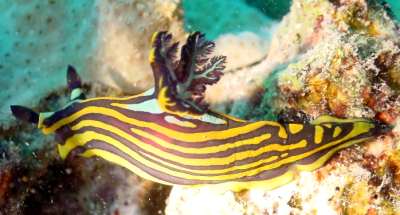
Dear Bill,
In the last paper on Tambja published by Marta Pola, Lucas Cervera and Terry Gosliner, you could see a photo of Tambja affinis from Mayotte. Here are 2 photos of the same specimen for the Forum.
Locality: 'Recif de Peitro', Kongou, Mayotte Island. Indian Ocean. Depth: 11 m. Length: 70 mm. 15 November 2003 . rocks. Photographer: Marina Poddubetskaia
Best wishes,
Marina.
Photos: Marina Poddubetskaia - Nembro website
nembro@nembro.info
Poddubetskaia, M,, 2005 (Aug 16) Tambja affinis from Mayotte. [Message in] Sea Slug Forum. Australian Museum, Sydney. Available from http://www.seaslugforum.net/find/14480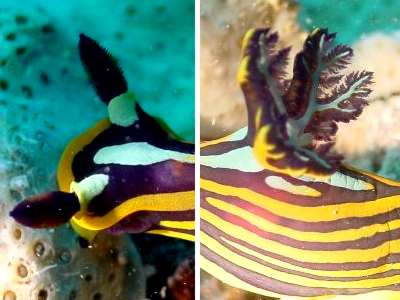
Dear Marina,
Thanks for these great photos. I've included a couple of close-ups alongside to show some of the detail of the colour pattern.
Best wishes,
Bill Rudman
Original description of Nembrotha affinis Eliot, 1904
August 16, 2005
From: Bill Rudman
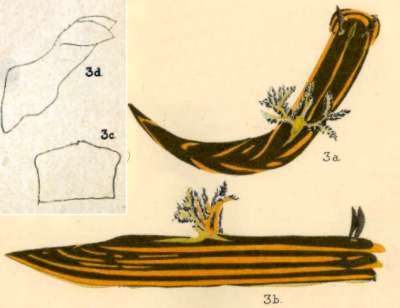
To accompany my update of the Tambja affinis Fact Sheet here is some information from the original description of Eliot's Nembrotha affinis, including the colour paintings of Cyril Crossland, who collected the specimen in Zanzibar and presented it preserved to Charles Eliot, with a written description of the living animals. From the description, and illustration of the radula, this species is more appropriately place in the genus Tambja.
The animal was 5 cms long alive and the soft animal was described as 'dull violet black ..... with dull yellow stripes on the sides and somewhat brighter ones of the same colour on the back. The stems and bases of the gills were light green, and the same colour occurred between the gills rhinophores and round the edges of their pockets. The pinnae of the gills looked black, but when seen with transmitted light were a fine purple.
-
Eliot, C.N.E. (1904) On some nudibranchs from East Africa and Zanzibar. Part V. Proceedings of the Zoological Society of London, 1904(2): 83-105, Pls.3-4.
Bill Rudman
Rudman, W.B., 2005 (Aug 16) Original description of Nembrotha affinis Eliot, 1904. [Message in] Sea Slug Forum. Australian Museum, Sydney. Available from http://www.seaslugforum.net/find/14564An update on Tambja in the Indo-West Pacific
August 16, 2005
From: Bill Rudman
As some of you will know, and as the other messages posted on the Forum today will make clear, a recently published paper on Tambja (Pola, Cervera & Gosliner, 2005) has made a valuable contribution to our knowledge of the group. It has also caused me to make some identification changes on the Forum in groups with very similar colour patterns.
I have made new Fact Sheets for the following species
Tambja affinis
Tambja gabrielae - previously Tambja sp. 5
Tambja victoriae - previously 'Roboastra arika' in part
Tambja zulu - previously Tambja sp. 3
I have also made a new page Tambja sp. 8 for an animal that looks quite like Tambja victoriae but may be a species of Roboastra. It also appears that Tambja sp. 4 still remains nameless.
I have also made a Tambja affiinis colour group page as a quick way to identify this group of species. It seems to me it can be done from the 'head' colour alone. Let me know if you find exceptions. Organising these changes has meant quite a bit if reorganising of old messages. I have checked but if anyone finds a message obviously in the wrong place could they let me know please. Congratulations to the authors.
-
Pola, M., Cervera, J.L. & Gosliner, T. (2005) Four new species of Tambja Burn, 1962 (Nudibranchia: Polyceridae) from the Indo-Pacific. Journal of Molluscan Studies, 71: 257-267
Bill Rudman
Rudman, W.B., 2005 (Aug 16) An update on Tambja in the Indo-West Pacific. [Message in] Sea Slug Forum. Australian Museum, Sydney. Available from http://www.seaslugforum.net/find/14574Tambja affinis from Sudan
May 3, 2003
From: Jan Reyniers
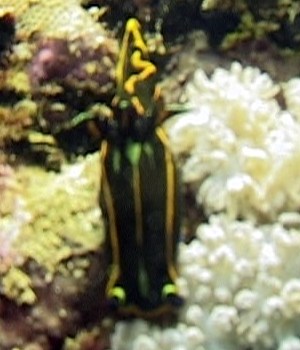
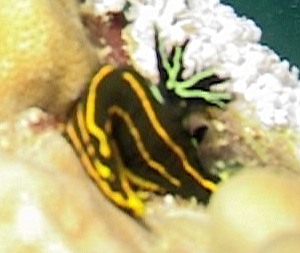
Can anybody identify this nudibranch found in Sudan, Port Sudan, Umbria wreck, Depth 18m (21 March 2003)
Thank you
Jan Reyniers
mastercarwash@pandora.be
Reyniers, J., 2003 (May 3) Tambja affinis from Sudan. [Message in] Sea Slug Forum. Australian Museum, Sydney. Available from http://www.seaslugforum.net/find/9616Dear Jan,
This is Tambja affinis. It has only been reported a few times since its original description from Zanzibar 100 years ago.
Best wishes,
Bill Rudman
Roboastra arika from Thailand
January 8, 2002
From: Erwin Koehler
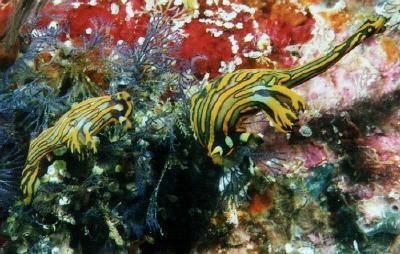
Note added 16 August 2005: This species is now re-identified as Tambja affinis.
Dear Bill,
Here is one from Thailand, Similan Island #9, divesite "Christmas Point",
depth 14m, sizes 28 + 42 mm, date Dec. 25, 2000. It looks like Roboastra
arika in Debelius book.
Erwin
Medslugs.Koehler@t-online.de
Koehler, E., 2002 (Jan 8) Roboastra arika from Thailand. [Message in] Sea Slug Forum. Australian Museum, Sydney. Available from http://www.seaslugforum.net/find/3617Thanks Erwin,
This is one of many messages which have been waiting too long to be published. Hopefully in the next two months I can reduce the backlog so that messages will again appear within a week or two of them being sent
Best wishes,
Bill Rudman
